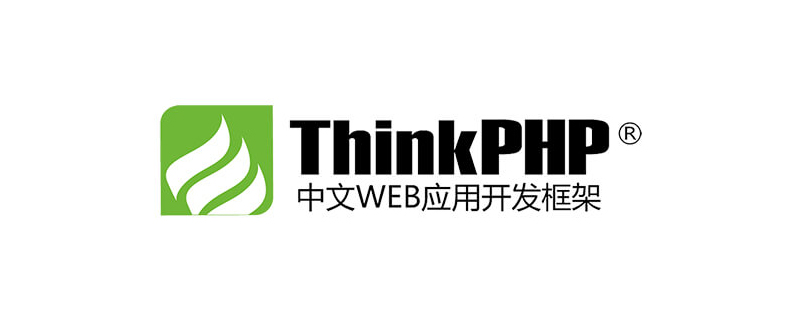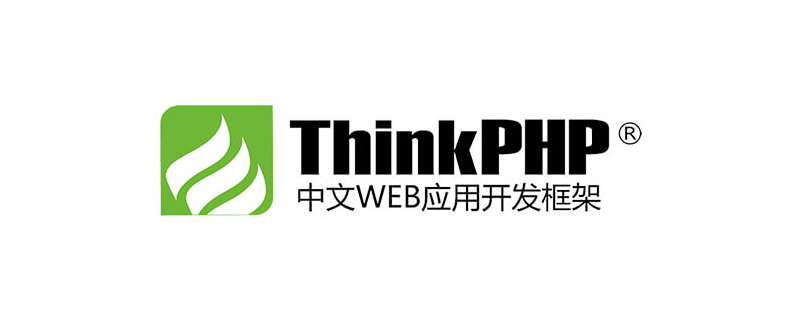In thinkphp, routing refers to the mapping assigned to the corresponding handler according to the URL; its function is to simplify the URL access address and make correct parsing according to the defined routing type. Simply put, routing is the parsing of a path. According to the path submitted by the client, the request is parsed to the corresponding module or controller or method.

The operating environment of this tutorial: Windows 7 system, thinkphp v5.1 version, Dell G3 computer.
Let’s study the routing mechanism of ThinkPHP5.
Although the complete development manual of TP5 talks about routing very clearly, we still study what the routing of TP5 is all about in this article. After all, reading a blog is more comfortable than reading a book.
First of all, ask three questions:
1. What is Route (routing)?
Route (route) refers to the mapping assigned to the corresponding handler based on the url.
Simply put, it is a path analysis. According to the path submitted by the client, the request is parsed to the corresponding module/controller/method.
The official document is defined like this=>The role of routing is to simplify URL access addresses and make correct parsing based on the defined routing type.
Manual explanation: When we usually access our ThinkPHP project according to our habits, the regular url should be written like this, (local example) http:// localhost/project name/public/index.php/module name/controller name/method name
After entering a string of URLs, you will feel very desperate, (whispering) = > "I just want to test a small interface that allows me to type such a long list of addresses. The address is too long and I can't remember it...". At this time, we can use routing to simplify his address, and define some rules while shortening the address.
2. Why use routing?
Some people may blurt out: To simplify the path. Of course, this is one of the reasons, but the reason is not that simple.
Simplifying the path is a big reason, because I thought the path was too long at first and ran over to turn it on. But later in the process of using it, I discovered the role of Route. In fact, it is not limited to simplified paths.
We can enable the forced use of routes so that everyone can only come in through the routes I defined. This has the advantage that you write some controllers that you don’t want users to access. Scripts, if you enable full routing for forced use, users will not be able to access these scripts. Otherwise, if users access these scripts and the scripts sometimes modify the database, it will be more dangerous.
Also, we can define whether it is a get operation or a post operation coming in from this path, so that there will be no situation like before. With a controller method, you can also get it from the get operation. It can be accessed, and post can also be accessed, which is very confusing. Of course, some people will say that it is not a big deal if both get and post can be accessed. In fact, it is more helpful to distinguish between these methods to embody the idea of Restful API. of.
Similarly, I won’t talk about the regulations of http and https.
At this point, do you think routing is a bit magical? It turns out that it can do so many things, so let’s study how to use it.
Using Route
Before using it, let’s first understand the configuration information. It’s still my fork project , open the config file:

There are two things to pay attention to, first of all, inside the first red box By default, tp turns on the routing mode for us. In the second red box, tp turns off the forced use of routing by default. What does it mean? Even now I can access successfully through our usual address mode, and access through routing can also be successful.

When I usually do projects, I will change this to true for safety reasons, so let’s take a look at the effect
Future When turning on forced routing:

Accessing according to the regular address can be successful, so let’s turn on forced routing now:

The same address reported an error and threw a route not found error. Because we did not define this route in the routing file, it threw an error. It shows that we are now forced to use routing.
So let’s define it now. First, start with the simplest one:

Find the route file

First of all, we need to introduce the routing class under think, and then we call the get static method inside. From the method name, we can easily know that this is accessed through the get method. , so what do the first and second parameters represent? The second parameter represents the module/controller/method in the regular URL, and the first parameter represents the name you want to use to replace the following module/controller/ method.
In other words, I originally used http://localhost/xx/public/index.php/xx/test/xx to access my controller method, but now I only need http://localhost/ xx/public/index.php/xx can access my controller method.
Look at the effect:

Successfully used routing access, then, let’s take a closer look at the formulation of this rule (for example, get and The difference between post access)
I now change the get method to the post method and then I use the get method to access and see what happens:



You can see that we use get which is not accessible. Only post can be accessed. How do you feel? Is routing a fun place?
More deeply, we can also define the route like this:

The third parameter represents the access method, like what I defined here This form is accessible to both get and post operations. The last parameter represents whether to check the https protocol. If it is false, https will not be checked. If it is true, we will not be able to find it when we use http to access it. In this way, we can further ensure the security of our interface. As for the effect, I won’t demonstrate it.
More
What else is special about routing? Routing can even merge the parameters passed by the get operation into the url. Our original get operation should look like this: url? id=1. After routing, we can define it as url/1. In this way, even the id parameter is hidden. Everyone knows the benefits. As for the process, just go to the development manual and search for it.
Of course, routing also has some other auxiliary functions, such as closure functions and so on. I will not introduce them one by one, because this auxiliary function is not very important during the development process. It is commonly used. If you are interested, you can go to the complete development manual to read it.
The relevant introduction to routing and the benefits of using routing are introduced here.
[Related tutorial recommendations: thinkphp framework]
The above is the detailed content of what is thinkphp routing. For more information, please follow other related articles on the PHP Chinese website!
 thinkphp是不是国产框架Sep 26, 2022 pm 05:11 PM
thinkphp是不是国产框架Sep 26, 2022 pm 05:11 PMthinkphp是国产框架。ThinkPHP是一个快速、兼容而且简单的轻量级国产PHP开发框架,是为了简化企业级应用开发和敏捷WEB应用开发而诞生的。ThinkPHP从诞生以来一直秉承简洁实用的设计原则,在保持出色的性能和至简的代码的同时,也注重易用性。
 一起聊聊thinkphp6使用think-queue实现普通队列和延迟队列Apr 20, 2022 pm 01:07 PM
一起聊聊thinkphp6使用think-queue实现普通队列和延迟队列Apr 20, 2022 pm 01:07 PM本篇文章给大家带来了关于thinkphp的相关知识,其中主要介绍了关于使用think-queue来实现普通队列和延迟队列的相关内容,think-queue是thinkphp官方提供的一个消息队列服务,下面一起来看一下,希望对大家有帮助。
 thinkphp的mvc分别指什么Jun 21, 2022 am 11:11 AM
thinkphp的mvc分别指什么Jun 21, 2022 am 11:11 AMthinkphp基于的mvc分别是指:1、m是model的缩写,表示模型,用于数据处理;2、v是view的缩写,表示视图,由View类和模板文件组成;3、c是controller的缩写,表示控制器,用于逻辑处理。mvc设计模式是一种编程思想,是一种将应用程序的逻辑层和表现层进行分离的方法。
 实例详解thinkphp6使用jwt认证Jun 24, 2022 pm 12:57 PM
实例详解thinkphp6使用jwt认证Jun 24, 2022 pm 12:57 PM本篇文章给大家带来了关于thinkphp的相关知识,其中主要介绍了使用jwt认证的问题,下面一起来看一下,希望对大家有帮助。
 thinkphp扩展插件有哪些Jun 13, 2022 pm 05:45 PM
thinkphp扩展插件有哪些Jun 13, 2022 pm 05:45 PMthinkphp扩展有:1、think-migration,是一种数据库迁移工具;2、think-orm,是一种ORM类库扩展;3、think-oracle,是一种Oracle驱动扩展;4、think-mongo,一种MongoDb扩展;5、think-soar,一种SQL语句优化扩展;6、porter,一种数据库管理工具;7、tp-jwt-auth,一个jwt身份验证扩展包。
 一文教你ThinkPHP使用think-queue实现redis消息队列Jun 28, 2022 pm 03:33 PM
一文教你ThinkPHP使用think-queue实现redis消息队列Jun 28, 2022 pm 03:33 PM本篇文章给大家带来了关于ThinkPHP的相关知识,其中主要整理了使用think-queue实现redis消息队列的相关问题,下面一起来看一下,希望对大家有帮助。
 thinkphp 怎么查询库是否存在Dec 05, 2022 am 09:40 AM
thinkphp 怎么查询库是否存在Dec 05, 2022 am 09:40 AMthinkphp查询库是否存在的方法:1、打开相应的tp文件;2、通过“ $isTable=db()->query('SHOW TABLES LIKE '."'".$data['table_name']."'");if($isTable){...}else{...}”方式验证表是否存在即可。
 thinkphp3.2怎么关闭调试模式Apr 25, 2022 am 10:13 AM
thinkphp3.2怎么关闭调试模式Apr 25, 2022 am 10:13 AM在thinkphp3.2中,可以利用define关闭调试模式,该标签用于变量和常量的定义,将入口文件中定义调试模式设为FALSE即可,语法为“define('APP_DEBUG', false);”;开启调试模式将参数值设置为true即可。


Hot AI Tools

Undresser.AI Undress
AI-powered app for creating realistic nude photos

AI Clothes Remover
Online AI tool for removing clothes from photos.

Undress AI Tool
Undress images for free

Clothoff.io
AI clothes remover

AI Hentai Generator
Generate AI Hentai for free.

Hot Article

Hot Tools

Atom editor mac version download
The most popular open source editor

VSCode Windows 64-bit Download
A free and powerful IDE editor launched by Microsoft

MinGW - Minimalist GNU for Windows
This project is in the process of being migrated to osdn.net/projects/mingw, you can continue to follow us there. MinGW: A native Windows port of the GNU Compiler Collection (GCC), freely distributable import libraries and header files for building native Windows applications; includes extensions to the MSVC runtime to support C99 functionality. All MinGW software can run on 64-bit Windows platforms.

SublimeText3 Linux new version
SublimeText3 Linux latest version

mPDF
mPDF is a PHP library that can generate PDF files from UTF-8 encoded HTML. The original author, Ian Back, wrote mPDF to output PDF files "on the fly" from his website and handle different languages. It is slower than original scripts like HTML2FPDF and produces larger files when using Unicode fonts, but supports CSS styles etc. and has a lot of enhancements. Supports almost all languages, including RTL (Arabic and Hebrew) and CJK (Chinese, Japanese and Korean). Supports nested block-level elements (such as P, DIV),







